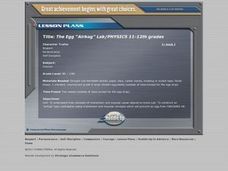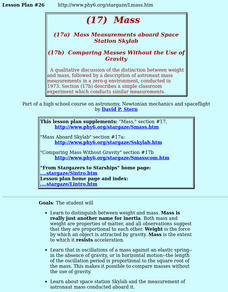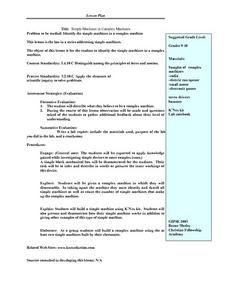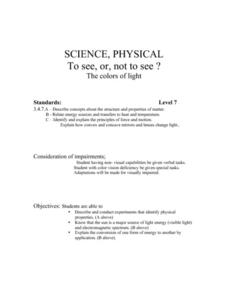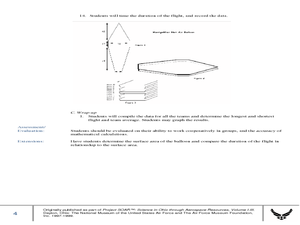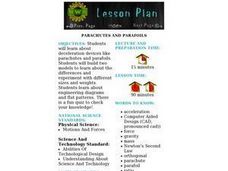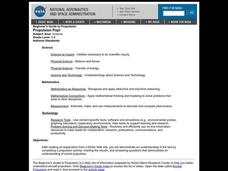Curated OER
Simple Machines
Ninth graders are shown a constructed machine and they asked what it is and what it does? They are questioned on type of simple machine constructed. Students are questioned on various parts of machine. They work in groups to design...
Curated OER
How Do The Colors of Light Mix?
Students investigate the mixing of light. They form a hypotheses to reason why color changes occur and they write conclusions and ask new questions arising from the investigation. Students identify the primary and complementary colors of...
Curated OER
The Egg "Airbag" Lab
Students use what they know about momentum and impulse to construct an effective "air bag" to protect an egg dropped from the top of the football stadium or other tall structure. They complete a final written report of their findings.
Curated OER
Bounce!
Students investigate the relationship between potential and kinetic energy. In this energy lesson students investigate the height a ball will bounce when dropped from various heights.
Curated OER
Biodiesel Combustion and Its Influences in NOx Emissions
Tenth graders evaluate the physical mechanisms that cause a change in NOx emissions. In this combustion lesson, 10th graders participate in a research project. Students create a presentation of their findings.
Curated OER
Mass
High schoolers participate in a qualitative discussion of the distinction between weight and mass, followed by a description of astronaut mass measurements in a zero-g environment.
Curated OER
Air Has Pressure
Seventh graders analyze evidence about particles and the exertion of air pressure. They observe an experiment with a hard boiled egg. fire and a bottle to discover the heating, cooling, and speed of air particles. They write explanations...
Curated OER
Blowin' In The Wind
Students predict and hypothesize the reasons for wind movement. After viewing a video, they describe the effects of a high and low pressure system and what makes the wind blow. In groups, they construct instruments that measure air...
Curated OER
Reflections
Students are given materials with various textures and light sources to investigate specular reflection, diffuse, reflection, angle of incidence, and angle of reflection. Students draw and label an everyday scenario showing specular and...
Curated OER
Snow Day
Eighth graders work in small groups to design and build a snow remover while looking at a snow design brief. They combine 2 or more simple machines to form a compound machine following the design brief in order to meet the required...
Curated OER
Simple Machines In Complex Machines
Students brainstorm the concept of a machine. They make lists of the characteristics that all machines share. The teacher uses questioning in order to get students to think more deeply about the subject. They create a lab to demonstrate...
Curated OER
To See or Not to See: The Colors of Light
Seventh graders describe and conduct an experiment that identifies the physical properties of light. They explore sources of visible light and an electromagnetic spectrum. Students explain the conversion of one form of energy to another.
Curated OER
Parachutes
Students control the parachutes using arm movements. They follow directions while participating in games. Students explore the effects of wind on several objects. They study the effects of shape, size and weight on a parachute.
Curated OER
Hot Friction
Sixth graders use small electronic devices known as thermistors to measure the temperature beneath an object such as a coffee cup as it slides across a surface. By choosing different surfaces, 6th graders can compare in a quantitative...
Curated OER
Electrostatic Review Worksheet
In this electrostatic worksheet, students determine the potential of a charge that moves in an electric field. Students define a coulomb, This worksheet has 5 multiple choice questions and 2 problems to solve.
Curated OER
Ocean Currents
Learners discover the geography of Earth by analyzing water currents. In this oceanography lesson plan, students create visual references on a map of the globe where and why major ocean currents are moving water. Learners...
Curated OER
Dimensional Analysis Problem Set
Students, after studying various pages of a NASA Web-based textbook, use dimensional analysis to verify actual aeronautic equations.
Curated OER
Impulse and Momentum
Students are introduced to the concepts of impulse and momentum and problem solving strategies for these types of problems. In groups, they discover the law of conservation of momentum and share their answers with the class.
Curated OER
Mathematical Techniques - Basic Graphing
Students are introduced to significant figures and how to add, subtract, multiply and divide them. In a group, they practice plotting data points from a table to a graph and labeling all axes. They calculate the slope and y-intercept and...
Curated OER
Up, Up and Away with the Montgolfier Balloon
Learners construct hot air balloons. In this science activity, students assemble their own balloon using tissue paper and glue. They time the duration of the flight, record data and calculate team averages.
Curated OER
Aircraft Trajectory Problem Set
Students, after reading an explanation from a NASA Web-based textbook, demonstrate an understanding of the text by applying it to the calculation of speed, distance, acceleration, and time in simple aircraft motion.
Curated OER
Did You Catch My Drift?
Students, through the use of the Curveball interactive software package, become familiar with the way in which the flow of air across or around an object affects its ability to lift, spin, and curve. After reading the explanation given...
Curated OER
Parachutes And Parafoils
Students study deceleration devices like parachutes and parafoils.
Curated OER
Propulsion Pop!
Young scholars demonstrate an understanding of the text by completing a propulsion activity, charting the results, and answering questions that demonstrate an understanding of rocket propulsion.


